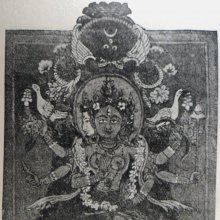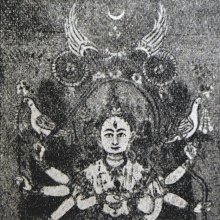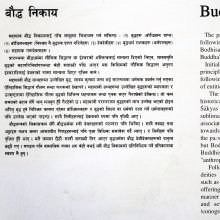Raksha, Raksa, Raksā, Rakṣa, Rakṣā, Rākṣā: 28 definitions
Introduction:
Raksha means something in Buddhism, Pali, Hinduism, Sanskrit, the history of ancient India, Marathi, Hindi, biology. If you want to know the exact meaning, history, etymology or English translation of this term then check out the descriptions on this page. Add your comment or reference to a book if you want to contribute to this summary article.
The Sanskrit terms Rakṣa and Rakṣā and Rākṣā can be transliterated into English as Raksa or Raksha, using the IAST transliteration scheme (?).
Images (photo gallery)
(+1 more images available)
In Hinduism
Purana and Itihasa (epic history)
Source: archive.org: Shiva Purana - English TranslationRakṣa (रक्ष) refers to “protection”, according to the Śivapurāṇa 2.5.19 (“Jalandhara’s emissary to Śiva”).—Accordingly, as Rāhu said to Śiva: “O great lord, O lord of the gods, save me who have sought refuge in you. You are always worthy of being worshipped by the gods and Asuras. You are the lord endowed with all riches and accomplishments. O great lord, your terrible servant has come here to swallow me, a Brahmin. O lord of gods, favourably disposed to your devotees, save me (rakṣa) lest he should devour me. Obeisance be to you again and again”.
Source: Cologne Digital Sanskrit Dictionaries: The Purana Index1a) Rakṣa (रक्ष).—A son of Vasiṣṭha and Ūrjā.*
- * Brahmāṇḍa-purāṇa II. 11. 41.
1b) The son of Khaśa: A fearful figure of three heads, three hands and three feet: roamed in the night in search of prey of men and animals.*
- * Brahmāṇḍa-purāṇa III. 7. 61-77.
1c) Meaning Pālana or protection from Rākṣasas.*
- * Vāyu-purāṇa 69. 101.
1d) Resides in the sun's chariot during the month of Śucī;1 Phālguna.2
1e) (also Rākṣasas) evil spirits.*
- * Bhāgavata-purāṇa X. 6. 27.
2a) Rakṣā (रक्षा).—The sister of Ṛkṣa; wife of Prajāpati and mother of Jāmbavan.*
- * Brahmāṇḍa-purāṇa III. 7. 299-300.
2b) The use of amulets to protect children and others from evils.*
- * Viṣṇu-purāṇa V. 5. 13.

The Purana (पुराण, purāṇas) refers to Sanskrit literature preserving ancient India’s vast cultural history, including historical legends, religious ceremonies, various arts and sciences. The eighteen mahapuranas total over 400,000 shlokas (metrical couplets) and date to at least several centuries BCE.
Pancaratra (worship of Nārāyaṇa)
Source: University of Vienna: Sudarśana's Worship at the Royal Court According to the AhirbudhnyasaṃhitāRakṣā (रक्षा) refers to “protection”, according to the Ahirbudhnyasaṃhitā, belonging to the Pāñcarātra tradition which deals with theology, rituals, iconography, narrative mythology and others.—Accordingly, “The practice is to be performed for the protection (rakṣā) of the Three Worlds, for the [welfare of the] earth, for the kingdom, the King or a Royal Officer. [It should be done] only for [their] good, never for evil [purposes]”.

Pancaratra (पाञ्चरात्र, pāñcarātra) represents a tradition of Hinduism where Narayana is revered and worshipped. Closeley related to Vaishnavism, the Pancaratra literature includes various Agamas and tantras incorporating many Vaishnava philosophies.
Sports, Arts and Entertainment (wordly enjoyments)
Source: archive.org: Syainika Sastra of Rudradeva with English Translation (art)Rakṣā (रक्षा) refers to a “tamer (of brids) (i.e., Hawks)”, according to the Śyainika-śāstra: a Sanskrit treatise dealing with the divisions and benefits of Hunting and Hawking, written by Rājā Rudradeva (or Candradeva) in possibly the 13th century.—Accordingly, [while discussing the treatment of hawks]: “An expert tamer of these birds (pakṣa-rakṣā-viśārada) should teach them how to fall upon a quarry, fastened by a string, and thus revive their old instincts. Those hawks, which have been taken from the nests, should be first tamed by being kept tied after their capture, and as they are unpractised in hunting, they should be taught in a variety of ways by an expert trainer of birds, by gradually increasing their skill and cleverness. [...]”.

This section covers the skills and profiencies of the Kalas (“performing arts”) and Shastras (“sciences”) involving ancient Indian traditions of sports, games, arts, entertainment, love-making and other means of wordly enjoyments. Traditionally these topics were dealt with in Sanskrit treatises explaing the philosophy and the justification of enjoying the pleasures of the senses.
In Buddhism
Tibetan Buddhism (Vajrayana or tantric Buddhism)
Source: archive.org: The Indian Buddhist IconographyRakṣā (रक्षा) or Pañcarakṣā, refers to the five protectresses (deities) as they are called in Tantric works. The Rakṣās are popular and well-known amongst the Mahāyāna Buddhists, particularly of Nepal. A manuscript copy of the Pañcarakṣā describing the five Rakṣā deities, their worship on different occasions and their powers, is to be found in almost every Buddhist house-hold in Nepal. Such manuscripts are often very artistically written and they bear miniature pictures of not only the five Rakṣā deities but alsoof other Buddhist deities such as the Dhyāni Buddhas and their Śaktis.
According to the Sādhanamālā, the five Rakṣā deities, when worshipped, grant long life. They protect kingdoms, villages and meadows. They protect men from evil spirits, diseases and famines, and from all possible dangers that may befall mankind. The Pañcarakṣā is recited in all varieties of domestic difficulties, such as, illnesses, adversities, loss of wealth, cattle, etc.
The five Rakṣā deities according to the Niṣpannayogāvalī are:
- Mahāpratisarā,
- Mahāsāhasrapramardanī,
- Mahāmantrānusāriṇī,
- Mahāśītavatī,
- Mahāmāyūrī.

Tibetan Buddhism includes schools such as Nyingma, Kadampa, Kagyu and Gelug. Their primary canon of literature is divided in two broad categories: The Kangyur, which consists of Buddha’s words, and the Tengyur, which includes commentaries from various sources. Esotericism and tantra techniques (vajrayāna) are collected indepently.
Mahayana (major branch of Buddhism)
Source: academia.edu: A Study and Translation of the GaganagañjaparipṛcchāRakṣā (रक्षा) refers to “protecting”, according to the Gaganagañjaparipṛcchā: the eighth chapter of the Mahāsaṃnipāta (a collection of Mahāyāna Buddhist Sūtras).—Accordingly, as Gaganagañja said to Ratnapāṇi: “Son of good family, the thirty-two dharmas are included in sixty-four dharmas. What are those sixty-four? [...] (9) the unhindered thought is included in protecting oneself (ātma-rakṣā) and protecting others (para-rakṣā); (10) the equal attitude to all living beings is included in the absence of distinction and a single taste; (11) indefatigability is included in the nature as a dream and the nature as an illusion; (12) works to be done for all beings is included in supernormal knowledges and skillful means; [...]’”.
Source: De Gruyter: A Buddhist Ritual Manual on AgricultureRakṣā (रक्षा) refers to “protection”, according to the Vajratuṇḍasamayakalparāja, an ancient Buddhist ritual manual on agriculture from the 5th-century (or earlier), containing various instructions for the Sangha to provide agriculture-related services to laypeople including rain-making, weather control and crop protection.—Accordingly, [As the afflicted Nāgas said to Bhagavān]: “[...] However, O Bhagavān, from today on I make a vow in the presence of the Tathāgata. Wherever this spell-holder king will circulate, there, O Bhagavān, the Nāgas will not make calamities again. Wherever this heart-dhāraṇī is used for protection (rakṣā), [there is] rescue, shelter, safeguard and the sealing of the boundaries and sealing of the maṇḍala. Where an amulet-cord is made, for that person, O Bhagavān, we will constantly ward off all calamities”.

Mahayana (महायान, mahāyāna) is a major branch of Buddhism focusing on the path of a Bodhisattva (spiritual aspirants/ enlightened beings). Extant literature is vast and primarely composed in the Sanskrit language. There are many sūtras of which some of the earliest are the various Prajñāpāramitā sūtras.
General definition (in Buddhism)
Source: Buddhist Door: GlossaryRaksa refers to those living in the Ghost Path.—Like Yaksa, they are evil and violent, but inferior to Yaksa.
India history and geography
Source: Project Gutenberg: Castes and Tribes of Southern India, Volume 1Raksha (“protecting”) is one of the gotras (clans) among the Kurnis (a tribe of South India). Kurni is, according to the Census Report 1901, “a corruption of kuri (sheep) and vanni (wool), the caste having been originally weavers of wool”. The gotras (viz., Raksha) are described as being of the Brāhman, Kshatriya, and Vaisya sub-divisions of the caste, and of Shanmukha’s Sudra caste.
Source: Cologne Digital Sanskrit Dictionaries: Indian Epigraphical GlossaryRakṣā.—(EI 17), confirmation of a former grant. Note: rakṣā is defined in the “Indian epigraphical glossary” as it can be found on ancient inscriptions commonly written in Sanskrit, Prakrit or Dravidian languages.
Source: What is India: Epigraphia Indica volume 27 (1947-1948)Rakṣā (रक्षा) refers to “(the law of) protection”, according to the Velūrpālaiyam plates of Nandivarman (II : S. I. I., Vol. II, p. 507. l.8).—Accordingly, “Thence came into existence the race of the Pallavas, who by the Law of Protection (rakṣā-vidhi) (they had adopted) removed even the slightest distress (of their subjects,) [...]”.
Source: Singhi Jain Series: Ratnaprabha-suri’s Kuvalayamala-katha (history)Rakṣā (रक्षा) (Prakrit) (in Sanskrit: Racchā) refers to “police posts (which were like defense citadels)” in ancient Indian cities, according to Uddyotanasūri in his 8th-century Kuvalayamālā (a Prakrit Campū, similar to Kāvya poetry).—The Kuvalayamala (779 A.D.) is full of cultural material which gains in value because of the firm date of its composition. [...] Page 58.32: There is a reference to racchā-caukka or Police posts which were like defense citadels garrisoned by soldiers and were a common feature of medieval administration Ṭhāṇe. These were also known as gulma-sthāna, the garrisioning contingent of the government, in Gupta administration and found in Mṛcchakaṭika. In the medieval period, the rakṣā-cātuṣkika had come into existence and is recorded in the inscription of Vastupāla and Tejapāla (Tejāpāla-praśasti, about 1225 A.D.).

The history of India traces the identification of countries, villages, towns and other regions of India, as well as mythology, zoology, royal dynasties, rulers, tribes, local festivities and traditions and regional languages. Ancient India enjoyed religious freedom and encourages the path of Dharma, a concept common to Buddhism, Hinduism, and Jainism.
Biology (plants and animals)
Source: Google Books: CRC World Dictionary (Regional names)Raksa in India is the name of a plant defined with Benincasa hispida in various botanical sources. This page contains potential references in Ayurveda, modern medicine, and other folk traditions or local practices It has the synonym Benincasa hispida Cogn. (among others).
Example references for further research on medicinal uses or toxicity (see latin names for full list):
· Flora Japonica (1784)
· Indian Journal of Pharmacology (2002)
· Systema Vegetabilium, ed. 14 (1784)
· Nova Acta Regiae Soc. Sci. Upsal. (1783)
· Monographiae Phanerogamarum (1881)
· Journal of Ethnopharmacology (2001)
If you are looking for specific details regarding Raksa, for example extract dosage, side effects, chemical composition, health benefits, diet and recipes, pregnancy safety, have a look at these references.

This sections includes definitions from the five kingdoms of living things: Animals, Plants, Fungi, Protists and Monera. It will include both the official binomial nomenclature (scientific names usually in Latin) as well as regional spellings and variants.
Languages of India and abroad
Marathi-English dictionary
Source: DDSA: The Molesworth Marathi and English Dictionaryrakṣā (रक्षा).—f (S) Ashes. 2 A twist of thread or tinsel bound as a preservative (against evil spirits) around the wrist at particular periods. 3 A string tied round the neck of a puerperal woman and of her infant on the sixth day after delivery. 4 A kept woman, a mistress. 5 S Preserving, keeping, protecting.
Source: DDSA: The Aryabhusan school dictionary, Marathi-Englishrakṣā (रक्षा).—f Ashes. Keeping.
Marathi is an Indo-European language having over 70 million native speakers people in (predominantly) Maharashtra India. Marathi, like many other Indo-Aryan languages, evolved from early forms of Prakrit, which itself is a subset of Sanskrit, one of the most ancient languages of the world.
Sanskrit dictionary
Source: DDSA: The practical Sanskrit-English dictionaryRakṣa (रक्ष).—[rakṣantyasmāt ityarthe asun Uṇādi-sūtra 4.196]
1) A guard, protector.
2) Preserving, guarding, watching.
Derivable forms: rakṣaḥ (रक्षः).
--- OR ---
Rakṣā (रक्षा).—[rakṣ-bhāve a ṭāp]
1) Protection, preservation; guarding; मयि सृष्टिर्हि लोकानां रक्षा युष्मास्ववस्थिता (mayi sṛṣṭirhi lokānāṃ rakṣā yuṣmāsvavasthitā) Kumārasambhava 2.28; Ś.2.15; R.2.4,8; Meghadūta 45.
2) Care, security.
3) A guard, watch.
4) An amulet or mystical object used as a charm, any preservative; as in रक्षाकरण्ड (rakṣākaraṇḍa) q. v. below.
4) A tutelary deity.
5) Ashes.
6) A piece of silk or thread fastened round the wrist on particular occasions, especially on the full-moon day of Śrāvaṇa, as an amulet or preservative; (rakṣī also in this sense).
7) Lac.
--- OR ---
Rākṣā (राक्षा).—See लाक्षा (lākṣā); (perhaps an incorrect form).
Source: Cologne Digital Sanskrit Dictionaries: Edgerton Buddhist Hybrid Sanskrit DictionaryRakṣā (रक्षा).—a set of magic formulas personified as a tutelary deity; five such: Dharmasaṃgraha 5 Pratisarā, Sāhasrapramardanī, Mārīcī, Mantrānusariṇī, Śītavatī; the same, often preceded by Mahā-, in various places in Sādhanamālā, see the names; pañ- carakṣā- Sādhanamālā 413.6; mahā-pañcarakṣā 402.13; see also, especially, Sādhanamālā 401.10 ff.; 405.1 ff. Instead of Śītavatī occurs (Mahā-)sitavatī. See Lévi, JA 1915.1.19.
--- OR ---
Rākṣa (राक्ष).—(nt.? in meaning = Sanskrit rakṣā, Pali rakkhā; Sanskrit rakṣa only adj. and n. ag.), protection: rākṣe ca sthitvā jina satkaroti Śikṣāsamuccaya 309.2 (verse), and he pays homage to the Jina(s), abiding in (their) protection.
Source: Cologne Digital Sanskrit Dictionaries: Shabda-Sagara Sanskrit-English DictionaryRakṣa (रक्ष).—mf.
(-kṣaḥ-kṣā) 1. Preserving, protecting. 2. Lac. f.
(-kṣā) 1. Ashes. 2. A tutelary deity. f. (-kṣikā-kṣī) A sort of bracelet, a twist of thread or tinsel, with a small packet containing a few carminative seeds, bound round the wrist at particular periods, especially at the day of full-moon in Sravana. E. rakṣ to preserve, aff. ac .
--- OR ---
Rākṣā (राक्षा).—f.
(-kṣā) Lac, the red animal dye. E. rakṣ to preserve, (colour,) a aff.; the vowel made long; perhaps an incorrect form of lākṣā .
Source: Cologne Digital Sanskrit Dictionaries: Benfey Sanskrit-English DictionaryRakṣa (रक्ष).—[rakṣ + a], I. m. One who guards, [Lassen, Anthologia Sanskritica.] 34, 8. Ii. m., and f. kṣā. 1. Preserving, guarding, [Pañcatantra] 184, 8; protecting, protection, [Pañcatantra] 157, 7. 2. (i. e. rañj + ta, cf. raktā, s.v. rañj), Lac. Iii. f. kṣā. 1. Ashes. 2. A sort of bracelet, an amulet, [Śākuntala, (ed. Böhtlingk.)] 105, 12 (Prakṛ.).
Source: Cologne Digital Sanskrit Dictionaries: Cappeller Sanskrit-English DictionaryRakṣa (रक्ष).—[feminine] ī protecting, guarding, keeping, watching; [masculine] protector, keeper. [feminine] ā guard, watch, protection, preservation; any preservative, [especially] a sort of bracelet or amulet.
--- OR ---
Rākṣā (राक्षा).—[feminine] lac (cf. lākṣā).
Source: Cologne Digital Sanskrit Dictionaries: Monier-Williams Sanskrit-English Dictionary1) Rakṣa (रक्ष):—[from rakṣ] 1. rakṣa mf(ī)n. (f(ā). See p.860) guarding, watching, protecting, serving
2) [v.s. ...] a watcher, keeper, [Suparṇādhyāya; Mahābhārata] etc. (mostly ifc.; cf. kṣetra-, go-, cakra-r etc.)
3) [from rakṣ] 2. rakṣa in [compound] for rakṣas.
4) Rakṣā (रक्षा):—[from rakṣ] f. the act of protecting or guarding, protection, care, preservation, security, [Manu-smṛti; Mahābhārata] etc.
5) [v.s. ...] a guard, watch, sentinel, [Mṛcchakaṭikā; Kāmandakīya-nītisāra]
6) [v.s. ...] any preservative, ([especially]) a sort of bracelet or amulet, any mysterious token used as a charm, [Bhāgavata-purāṇa; Suśruta]
7) [v.s. ...] a tutelary divinity (cf. mahā-r)
8) [v.s. ...] ashes (used as a preservative), [cf. Lexicographers, esp. such as amarasiṃha, halāyudha, hemacandra, etc.]
9) [v.s. ...] a piece of thread or silk bound round the wrist on [particular] occasions ([especially] on the full moon of Śrāvaṇa, either as an amulet and preservative against misfortune, or as a symbol of mutual dependence, or as a mark of respect), [Monier-Williams’ Sanskrit-English Dictionary]
10) Rākṣā (राक्षा):—f. = lākṣā, lac, [Uṇādi-sūtra iii, 62 [Scholiast or Commentator]]
Source: Cologne Digital Sanskrit Dictionaries: Yates Sanskrit-English Dictionary1) Rakṣa (रक्ष):—[(kṣaḥ-kṣā-kṣaṃ) a.] Preserved or preserving. m. f. Preservation; lac. f. Ashes; a sort to bracelet.
2) Rākṣā (राक्षा):—(kṣā) 1. f. Lac.
Source: DDSA: Paia-sadda-mahannavo; a comprehensive Prakrit Hindi dictionary (S)Rakṣa (रक्ष) in the Sanskrit language is related to the Prakrit words: Rakkha, Rakkhā.
[Sanskrit to German]
Sanskrit, also spelled संस्कृतम् (saṃskṛtam), is an ancient language of India commonly seen as the grandmother of the Indo-European language family (even English!). Closely allied with Prakrit and Pali, Sanskrit is more exhaustive in both grammar and terms and has the most extensive collection of literature in the world, greatly surpassing its sister-languages Greek and Latin.
Hindi dictionary
Source: DDSA: A practical Hindi-English dictionary1) Raksa (रक्स):—(nm) dance, dancing; dance performance.
2) Raksha in Hindi refers in English to:—(nm) see [riksha]..—raksha (रिकशा) is alternatively transliterated as Rikaśā.
...
Kannada-English dictionary
Source: Alar: Kannada-English corpusRakṣa (ರಕ್ಷ):—
1) [noun] the act or an instance of protecting, guarding a person or a thing; protection.
2) [noun] a man who protects; a protector; a guard.
3) [noun] (dance.) a kind of hand gesture in giving protection.
Kannada is a Dravidian language (as opposed to the Indo-European language family) mainly spoken in the southwestern region of India.
See also (Relevant definitions)
Starts with (+147): Raksha-bhoga, Rakshabamdha, Rakshabandhana, Rakshabandhanavidhi, Rakshabhagavati, Rakshabhushana, Rakshabhyadhikrita, Rakshacatushkika, Rakshadala, Rakshadhikrita, Rakshadhipati, Rakshagandaka, Rakshagriha, Rakshah, Rakshahpala, Rakshahpasha, Rakshahpati, Rakshahprakandaka, Rakshahsabha, Rakshahsabham.
Ends with (+185): Abhiraksha, Adavi draksha, Adavi teega draksha, Adavi-draksha, Adavi-teega-draksha, Adavi-tiga-draksha, Adavidraksha, Adhiraksha, Amritasamraksha, Ancitapattraksha, Angaraksha, Annapanaraksha, Annaraksha, Annasamraksha, Anuraksha, Aparaksha, Araksha, Ashvaraksha, Asuraksha, Atmaraksha.
Full-text (+567): Rakshas, Rakkha, Samraksha, Senaraksha, Rakshasa, Rakshapala, Pishitasha, Rakshahsabha, Padaraksha, Goraksha, Shirsharaksha, Nikharvata, Rakshoghna, Puraraksha, Nishacara, Araksha, Rakshah, Rakshapurusha, Rakshaspasha, Angaraksha.
Relevant text
Search found 100 books and stories containing Raksha, Raksa, Raksā, Rakṣa, Rakṣā, Rākṣā, Rākṣa; (plurals include: Rakshas, Raksas, Raksās, Rakṣas, Rakṣās, Rākṣās, Rākṣas). You can also click to the full overview containing English textual excerpts. Below are direct links for the most relevant articles:
Rig Veda (translation and commentary) (by H. H. Wilson)
Garga Samhita (English) (by Danavir Goswami)
Verse 1.10.15 < [Chapter 10 - Description of the Birth of Lord Balarāma]
Verse 3.2.14 < [Chapter 2 - The Great Festival of Śrī Girirāja]
Verse 1.5.25 < [Chapter 5 - The Lord’s Appearance]
Shaiva Upanishads (A Critical Study) (by Arpita Chakraborty)
8b. Different names of Bhasma < [Chapter 2 - Greatness of Bhasma and Dhāraṇa]
The Indian Buddhist Iconography (by Benoytosh Bhattachacharyya)
Figure 197 - Five Protectresses (2): Mahāsāhasrapramardanī
Figure 200 - Five Protectresses (5): Mahāmāyūrī
Chaitanya Bhagavata (by Bhumipati Dāsa)
Verse 3.5.626 < [Chapter 5 - The Pastimes of Nityānanda]
Verse 1.4.7 < [Chapter 4 - Name-giving Ceremony, Childhood Pastimes, and Thieves Kidnap the Lord]
Verse 2.13.100 < [Chapter 13 - The Deliverance of Jagāi and Mādhāi]
The Garuda Purana (by Manmatha Nath Dutt)
Chapter LVIII - Positions and dimensions of the sun and other planets < [Agastya Samhita]
Chapter XL - Maheshvara worship < [Agastya Samhita]
Chapter XIII - The prayer of Vishnu Panjaram < [Agastya Samhita]
Related products






